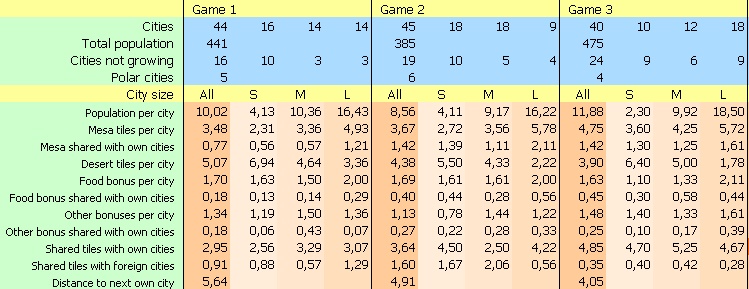I autoplayed 3 games and printed out some nice statistics about our current situation.
Map settings:
Map script: Arrakis.py
Map size: Standard
Game speed: Quick
Players: 7
Pangaea style
Game options:
only "no barbarian" is checked
Victories:
All but last two
Statistics always taken on turn 250/330

As you can see we have problems with the average population (only 10). There are also a lot of small cities, even in late game. Some of them were maybe just founded recently.

Be careful with "Cities not growing"-line. No growth doesn't automatically indicate a bad location, but also could result from misplaced improvements.
Mesa tiles per city: We already guessed it, the amount of mesa tiles is one of the key factors to get a good city location. Similar situation in the "Food bonus per city"-line.
Desert tiles per city: This is interesting. Having a lot of desert tiles inside a bfc dramatically reduce the quality of a city site. I think this is a good argument for outsourcing spice harvest outside of the bfc.

Mesa shared/Food bonus shared: As you can see there isn't any relation between tiles shared with other cities and the size of a city. This disproves Ahriman claiming shared tiles are a major reason for cities not growing.
Another problem I run into while coding the statistics is, that spice is counted as a regular commerce bonus, making it completly overrated.
So my first steps in improving ai_foundvalue will be:
- writing a true algorithm to count mesa tiles available for wind traps
- dramatically increasing values for peaks (=mesa)
- rejecting all city sites with less than 2 food bonuses
- excluding spice bonus from found value
- giving a small penalty for desert(=water) tiles
- removing all checks related to coastal/area
- increasing the malus for founding cities too close
- rejecting city home plots habouring bonuses
If you want print out statistics for yourself, here is a modified Dunewars.py. Copy it to "DuneWars/Assets/Python". It is working with 1.6.1 and 1.6.2. In turn 250 a file "betterCityAI.log" will created in your bts folder.




 . It teachs the ai where to found cities first. Think about the consequences, especially for ai autoplay results!
. It teachs the ai where to found cities first. Think about the consequences, especially for ai autoplay results!